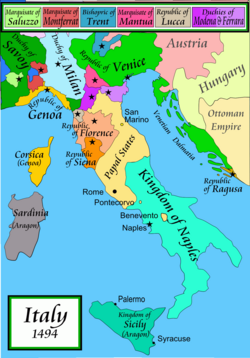March of Saluzzo
| Marquisate of Saluzzo | ||||||||
| Marchesato di Saluzzo | ||||||||
|
||||||||
| Capital | Saluzzo | |||||||
| Religion | Catholic | |||||||
| Government | Marquisate | |||||||
| Marquis | ||||||||
| • | 1125–1175 | Manfred I of Saluzzo (first) | ||||||
| • | 1537–1548 | Gian Gabriele I of Saluzzo (last) | ||||||
| History | ||||||||
| • | Donation of Boniface del Vasto to his son Manfred | 1125 | ||||||
| • | Annexion to France | 23 February 1548 | ||||||
|
||||||||
The Marquisate of Saluzzo was a historical Italian state that included French and Piedmont territories on the Alps.
The Marquisate of Saluzzo occupied parts of the provinces of Cuneo and Turin, and at times areas now under French control. However, Saluzzo was historically the area between the Stura, the Po and the Alps. the del Vasto family, who ruled Saluzzo throughout its period, also owned other areas in Liguria and Italy for the many arranged marriages, but Saluzzo never saw these territories annexed to it. Probably, if there had not been the Italian advance of Savoy, Saluzzo might have been able to conquer other lands in Piedmont, which ranking as one of the main Italian signorie.
The ancient and noble dynasty of Liguria was located in the region around Ventimiglia. The House of Del Vasto became masters of the city when Ulric Manfred II of Turin chose to enfeoff Boniface del Vasto as marquis. His eldest son Manfred inherited it. From that moment the del Vasto became Marquis of the Piedmontese town and handed the title dynastically as a true signoria.
Manfred II tried to extend the marquisate beyond its domain so battled with the Savoy. After Manfred's death, his widow Alasia had to provide them a number of tributes per year: from these tributes, Savoy established claims of mastery over the marquisate which led them to clash repeatedly against the weak Marquis.
Often torn by internal dissension, Saluzzo reached the period of greatest splendor under the Marquess of Ludovico I and Ludovico II in the 15th century: the first, with a policy neutral to Italian belligerence, was able to act as mediator between the discord and received praises from the emperor and the king of France; the second looking for the glory on the battlefield, was repeatedly beaten, beginning the end for the glory of the Marquisate. During his reign, however, he was attentive in developing trade by building the first Alpine tunnel, the Buco di Viso connecting with a safe road Saluzzo with the Dauphiné and Provence.
...
Wikipedia


